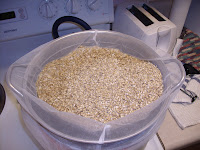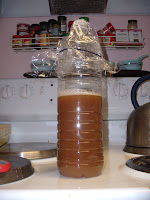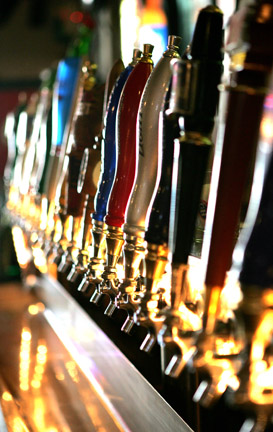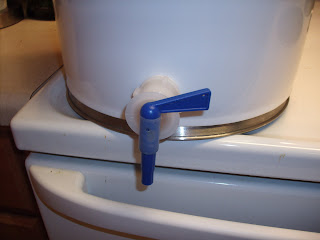Greetings drinkers! Been too long. The dog days of summer sapped my blogging strength, but the stirrings of brisk autumn breezes and the promise of (fantasy) gridiron glory have restored my waning potency. So, a few updates:
ITEM! As the resident Johnny Beerseed of Northwest DC, I have introduced my neighbor down the hall to the hobby of homebrewing and helped him get his first batch underway. Not only that, but he has eclipsed me in the equipment area, already having procured TWO kegs and the requisite fittings. Sigh, they grow up so fast...
ITEM! Mrs. Brew Dude and I spent a piece of the long weekend brewing up our first repeat brew: Green Chile Beer. It's a wheat ale base, but we "dry hop" it with 5 skinned and seeded jalapeno peppers. Deee-lish with nachos!
ITEM! Ordered up a fresh batch of ingredients for brews to last well into the winter months. With a pumpkin porter, a nut brown, and a winter wheat on deck, we should have plenty of homebrew to keep us warm.
And, lastly, in order to cross something off the list of
40 Things Every Drunk Should Do, here is the first chapter of my memoir,
Grapes, Grains, and Glory: A Life in Booze.
The first taste of beer I can recall was at a barbecue, held by one of my mother's work acquaintances. I was probably 6 or so, since I was still enthralled by action figures and most of my worldview was shaped by gossip under the jungle gym.
The barbecue was one of those potluck affairs that start in the early evening and go later than the hosts probably intended. It was dark by the time the grownups decided that the party should be moved indoors. I had been running around the neighborhood with other kids my age. The instant friendship between male youths discovering their shared love of the Turtles. When we were called back in, I needed to slake my thirst, and a sweaty Solo cup of iced Pepsi was just the ticket.
However, it was not my cup that I had picked up, but a similar looking one belonging to one of the more aged revelers. My deep draft of what was supposed to be sugary goodness was instead bitter and foul. If you have ever opened what you thought was a soda and instead got beer, even as a seasoned drinker, you know the sensation. Beer is best tasted on the top middle of the tongue, but soda likes to be on the sides, for maximum sweetness.
I swallowed out of panic, not knowing what else to do. I realized: I had just ingested an ADULT BEVERAGE meant for GROWNUPS ONLY. The prevailing wisdom of the aforementioned jungle gym was that drinking before your time was not only verboten, but wholly FATAL. Like a switch is flipped when you reach 21 making beer not poisonous.
But who to tell? As afraid as I was of my impending death, I feared the disappointed looks of my parents even more. Not only was I dying, but I had let down my family. No, better to suffer in silence and wither away quietly.
The next few days, I awaited death's cold touch, resigned to my fate. But, miracle of miracles, a whole week passed and I didn't even have a fever. I had done it! I had BEATEN DEATH!
As always, time marched on and my brush with mortality was revealed to simply be tasting a bitter fruit before I was ready, and much less life-threatening than I had been led to believe. And of course, today, I am a Death Dealer, creating my own noxious unguents and passing them around amongst my (of age) peers.
What doesn't kill you, makes you drunker.
Cheers!

 Since we are using flaked rice, this will require a multi-step mash to adequately break down the fermentable sugars in our grains. The first step is to heat up the strike water that the grain will be added to. I want my final volume into the fermentor to be 2.5 gallons, so I have 3.5 gallons in the brew kettle to start to compensate for the grains soaking up water and whatever will steam off during the boil.
Since we are using flaked rice, this will require a multi-step mash to adequately break down the fermentable sugars in our grains. The first step is to heat up the strike water that the grain will be added to. I want my final volume into the fermentor to be 2.5 gallons, so I have 3.5 gallons in the brew kettle to start to compensate for the grains soaking up water and whatever will steam off during the boil. As you can see, the paint strainer bag fits nicely over my 5 gallon brew kettle. Once the water is sufficiently heated, we dump in the grain and stir, stir, stir.
As you can see, the paint strainer bag fits nicely over my 5 gallon brew kettle. Once the water is sufficiently heated, we dump in the grain and stir, stir, stir. My lager recipe call for rests at 122°, 140°, 158° and mash-out at 170°F. Traditional brewers accomplish these rests by starting with less water and adding more hot water as they go along. But I just used my stove top and the last few minutes of one rest to ramp up to the next one. Seemed to work ok.
My lager recipe call for rests at 122°, 140°, 158° and mash-out at 170°F. Traditional brewers accomplish these rests by starting with less water and adding more hot water as they go along. But I just used my stove top and the last few minutes of one rest to ramp up to the next one. Seemed to work ok. Once the mash is complete and most of the fermentable sugars have been steeped out of the grains, we simply lift the strainer bag out of the brew kettle and the sweet wort is left behind. I put the moist grains in a colander resting on top of my brew kettle and let it drip for a few more minutes.
Once the mash is complete and most of the fermentable sugars have been steeped out of the grains, we simply lift the strainer bag out of the brew kettle and the sweet wort is left behind. I put the moist grains in a colander resting on top of my brew kettle and let it drip for a few more minutes. After that, brewing proceeds as normal, with three hop additions splitting up the hour-long boil.
After that, brewing proceeds as normal, with three hop additions splitting up the hour-long boil. After the boil, I chilled the wort off in the sink. I may need to buy a bag of ice for my next brew, since there is a lot of thermal mass in there and just sitting in cool sink water led to about a 45 mintue wait until it had reached yeast pitching temperature.
After the boil, I chilled the wort off in the sink. I may need to buy a bag of ice for my next brew, since there is a lot of thermal mass in there and just sitting in cool sink water led to about a 45 mintue wait until it had reached yeast pitching temperature. Since this is a lager, I let it begin fermentation for one day at room temp, and then stuck it in the fridge. Hopefully this will produce a clean, crisp summer beer.
Since this is a lager, I let it begin fermentation for one day at room temp, and then stuck it in the fridge. Hopefully this will produce a clean, crisp summer beer. As you can see, it's a bit hazy with a decent white head. It is less hoppy than most examples, with a smell I can only describe as beery (in the most positive sense one can take that). It has a sweet, bready and fruity taste, and finishes with an ever-so-slightly hoppy and crisp aftertaste.
As you can see, it's a bit hazy with a decent white head. It is less hoppy than most examples, with a smell I can only describe as beery (in the most positive sense one can take that). It has a sweet, bready and fruity taste, and finishes with an ever-so-slightly hoppy and crisp aftertaste. Truly a thing of beauty, yes?
Truly a thing of beauty, yes?

 Using this, I will be able to mash the grains and then do the subsequent boil for an entire 2.5 gallon batch. No more splitting it up!
Using this, I will be able to mash the grains and then do the subsequent boil for an entire 2.5 gallon batch. No more splitting it up! They were $4 for a two-pack at my neighborhood hardware store. The bag will hold the grain while it steeps in the hot water. Then I can just pull it out, dump the grain, wash the bag, and it's ready to go again.
They were $4 for a two-pack at my neighborhood hardware store. The bag will hold the grain while it steeps in the hot water. Then I can just pull it out, dump the grain, wash the bag, and it's ready to go again.













 I am now letting the least wake up and get happy until this evening. Then, I will pitch the yeast into a starter wort: a small amount of malt that the yeast can eat to power their furious, passionate reproduction. Slow jazz optional.
I am now letting the least wake up and get happy until this evening. Then, I will pitch the yeast into a starter wort: a small amount of malt that the yeast can eat to power their furious, passionate reproduction. Slow jazz optional.




 As the plaid-shirted douche tells us, we should drink Bud Light because of its "drinkability."
As the plaid-shirted douche tells us, we should drink Bud Light because of its "drinkability."
 Miller Lite has abandoned "Tastes Great/Less Filling" catfights and celeb-soaked "Man-Law" roundtables for a more craft-oriented advertising approach: telling you to drink their beer because it is "triple-hops" brewed.
Miller Lite has abandoned "Tastes Great/Less Filling" catfights and celeb-soaked "Man-Law" roundtables for a more craft-oriented advertising approach: telling you to drink their beer because it is "triple-hops" brewed.





